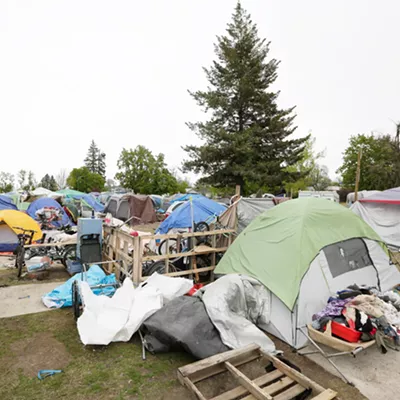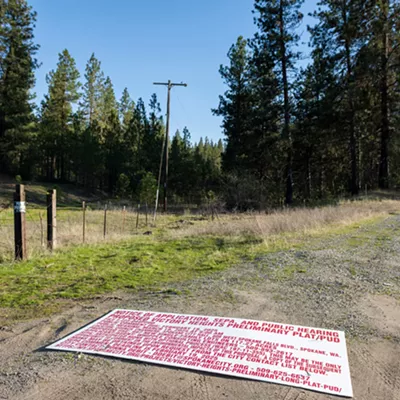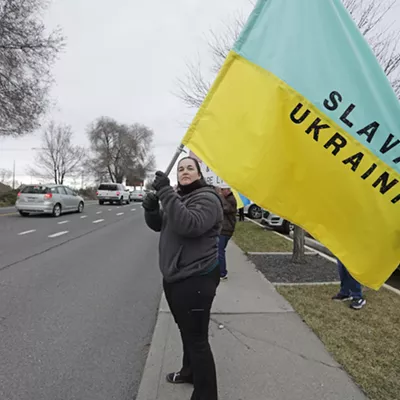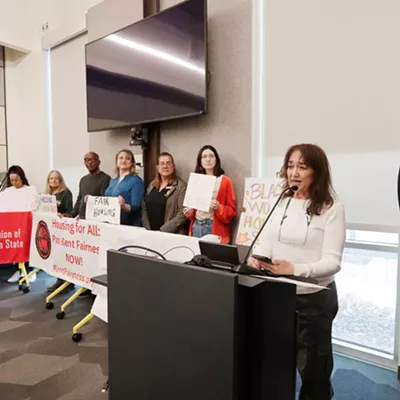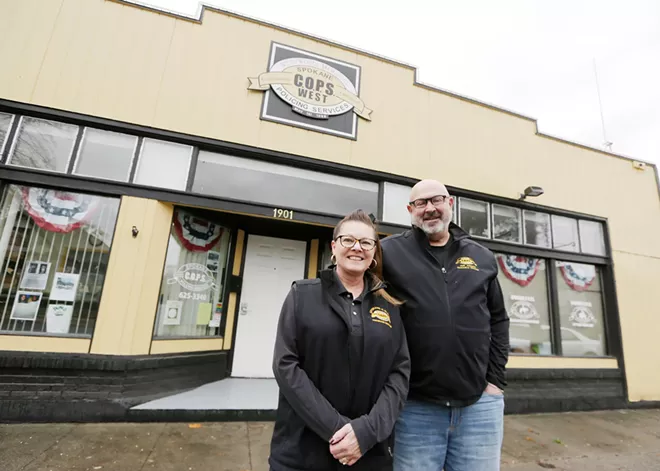
A slate of election results poured in last week, but the decision that might affect Spokane residents most immediately and materially is the passage of Proposition 1.
The requested 0.1% increase in sales tax passed with about 58% of the vote as of Nov. 8. The tax will go into effect in January, and the revenue will go into the newly created "Community Safety Sales Tax Fund."
Mayor Lisa Brown promises that the revenue generated, an estimated $6.5 million per year for the city, will go toward new investments into the fire department, the police department, the municipal court and the Office of Police Ombuds.
The dollars headed to the fire department, municipal court and police ombuds have cut-and-dry designations — new fire trucks and new jobs. But the plan for the millions designated to the police department over the next two years is less clear.
Both Brown and new Police Chief Kevin Hall say that the money will fund seven new neighborhood resource officers. But the police department, the mayor's administration and the communities they serve are trying to reimagine what exactly neighborhood policing means.
"A major part of this proposition was that we would bring that [neighborhood resource officer] program back," Hall says. "So now my job is how to best utilize them. What NROs looked like in the past may not be what they look like in the future. The world changes, policing changes and community expectations change."
In the midst of this, the police department's contract with Community Oriented Policing Services, or C.O.P.S., is expiring at the end of the year. The 30-year-old nonprofit, founded in the West Central neighborhood, was usually a shoo-in for a contract as a community liaison for the police department. But now, partially due to a lack of quantifiable success metrics, it's being reconsidered along with everything else as the city tries to close the budget gap, which started at around $50 million when Brown took office early this year.
"My administration's intention would be to do a request for proposals and let organizations that can provide some of those services participate in that competitive process," Brown says. "We are asking the question, 'Is there a way for this to be more coordinated and cohesive?'"
BUDGET PROPOSAL
Proposition 1 passed in each of the city's three districts. But some neighborhoods were more enthusiastic about it than others.
According to an Inlander analysis using tabulations from Nov. 8, the proposition passed with the largest margin in District 2, which covers the South Hill, where it won about 62% of the vote. It won about 54% and 55% of the votes in Districts 1 and 2, respectively.
"I'm really pleased that we had such a strong showing," Brown says. "That's always a good thing when it's north of the river and south of the river."
Brown was optimistic enough about the proposition's chances of passing that she included the revenue in her biennial budget proposal, which she released on Nov. 2, the Saturday before Election Day.
"I was completely stunned to see any reference to Prop. 1 in the budget after they had, on multiple occasions, told us that the budget would not in any way have any reliance upon Prop. 1," Spokane City Council member Michael Cathcart says.
Brown says the budget doesn't rely on Prop. 1 dollars, since her administration was able to balance the budget without the new revenue. She promises that the new revenue will only go toward new investments, and those are what she listed in the proposed budget.
To close the budget gap, Brown's team made new agreements with union bargaining units that included voluntary retirement incentives, plus eliminated unfilled positions, reorganized some staff responsibilities, and also took some unpaid furlough days themselves.
"That moved resources and expenditures in line with each other so that this community safety proposal could go to the things that we said all along we would spend it on," Brown says. "So we baked [Prop. 1 revenue] into the budget that I proposed last week already."
Thanks to the new revenue stream, all 10 potential layoff notices to criminal justice service employees at the municipal court were rescinded on Thursday, Nov. 7, says Deputy City Administrator Maggie Yates.
Keeping current municipal court jobs might not seem like a new investment, but these were temporary, experimental positions, so maintaining them as permanent is faithful to the promise of Prop. 1, Brown and Yates say.
"The budget that was passed last year only funded some of these criminal justice specialists and counselors for half the year," Yates says. "It was called a pilot project, and it's understood to be a very effective program. So this funding allows all of that to continue."
Of the 29 potential layoffs announced earlier this fall, only three people at the city will actually lose their jobs under the current proposed budget, Yates says — one civilian employee from the Police Department, one civilian employee from the Fire Department and one employee from the Information Technology Department.
COMMUNITY-ORIENTED POLICING
On the day after Election Day, Sandi McIntyre sits behind the front desk of the yellow C.O.P.S. shop on Boone Avenue. On the wall behind her hang framed portraits of two elementary school-aged girls who were kidnapped and killed in West Central three decades ago.
Their deaths prompted community outrage and, soon after, the formation of a nonprofit dedicated to community-oriented police volunteers. The idea was to train neighbors to be eyes and ears in their communities, hopefully preventing crime with their presence while keeping track of issues like drug houses and chronic nuisance properties.
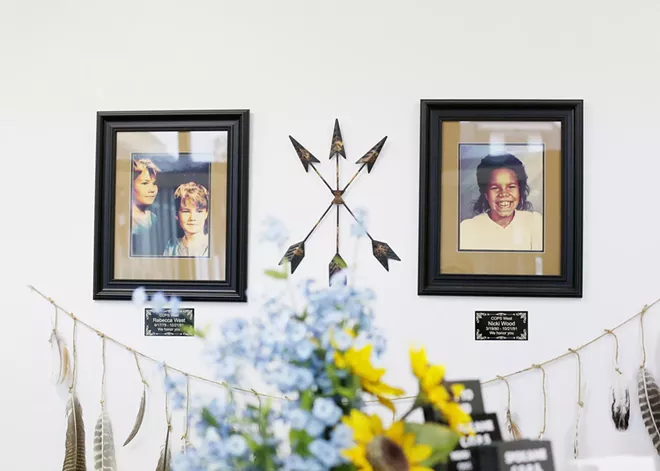
Some C.O.P.S. volunteers are trained by forensic experts to take fingerprints from minor burglary crime scenes. They also register bikes and organize local school patrols.
McIntyre used to be a Spokane Police Department neighborhood resource officer in north Spokane for three years. As an NRO, she says she relied on her local C.O.P.S. shop to give her quick intel on neighborhood issues.
"I would come in and I would check with my volunteers, 'What's going on? Where's my paperwork? Where's my reports? Let's talk about this stuff,'" she says.
Now, McIntyre is the program manager for the eight C.O.P.S. shops around the city. The neighborhood buildings are usually staffed by volunteers, who offer neighbors a place to report a nuisance or request a service. The shops also give police officers a place to park their cars, write reports or eat lunch. Plus, they house community correction officers from the Department of Corrections.
"They're in the neighborhood," says Jeff Johnson, executive director of C.O.P.S. "They're not making it hard for someone who just got out of prison to see [their] parole officer. We are making it easier by being in the neighborhoods."
The nonprofit's five-year contract with the police department, which made C.O.P.S. the sole provider for community-police liaison services, is expiring at the end of December.
It's giving the city a chance to rethink how to invest in community-oriented policing at the same time the police department is reimagining what neighborhood resource officers, or NROs, will do.
"There are things that we are being asked to do that are not appropriate for police to be involved in, and other people are better suited," says Hall, who was sworn in as police chief at the end of August. "Hopefully the NROs will be navigators to those services and be able to connect those different services with the different issues and the people who are complaining in these different neighborhoods as well as downtown."
Hall says neighborhood resource officers will not be dispatched on calls the way other officers are, and that they'll be dedicated to the four different police precincts, a concept most people expect.
"What they're mostly known for is addressing nuisance properties in the neighborhoods with the city attorney's office and working to clean those up or gain compliance from the tenants," Hall says. "So that's not going to go away. But we just intend on adding to their list of tasks and duties. That's going to include a lot of community engagement and could cross over into some recruitment efforts and other things that we've scaled back on, [things] that they're perfectly situated for because of the place they'll have within the community."
The new neighborhood resource officers will be dispatched two at a time over the next few months into the neighborhoods that need them most, Hall says. Downtown is a neighborhood, too, he says, and it's at the top of his list for new neighborhood officers.
With the expanded vision, Hall and Brown are trying to understand which organizations could be the best liaisons between communities and officers.
As C.O.P.S. requests a new multiyear contract for $475,000 a year, Hall wants to make sure every dollar goes to a sustainable and proven investment. As the new guy in town, he's depending more on data than tradition.
"The C.O.P.S. metrics are not exactly what I wanted to see," Hall says. "From a business standpoint, it's hard for me to support a program where the performance metrics just aren't there."
Maybe they did do a lot of work, Hall says, but if there's no data to verify it, that's a problem for him.
"I do struggle with, 'How do we best support them moving forward?' I do want to support them," Hall says. "There's obviously some love in the community for this program that's been around for several decades. But at the same time, I need to make sure it's a responsible use of taxpayer dollars."
Woody Garvin is a retired pastor who's volunteered with C.O.P.S. for five years. He's also part of the West Central Development Project, which meets in the C.O.P.S. shop on Boone regularly to discuss how to improve the neighborhood's quality of life.
"One of the things we help do is to bridge people who may not feel good about police presence by being an extra interface with the community," Garvin says. "It's what really helps soften things. It helps people feel the presence. It helps them get over a fear of police because they get to meet them face to face. That would not happen without the cop shop. It would just be police cars going up and down the street."
Not everyone agrees, including Virla Spencer, executive director of The Way to Justice, a local nonprofit law firm that offers legal assistance, especially to communities of color. When the city puts out a request for proposals in December or early January, she would like The Way to Justice to apply to be a liaison between neighborhoods and police.
"I have never been able to walk inside of a C.O.P.S. shop to be able to receive any services, let alone have I ever heard of any Black or brown folks ever having any good luck with any of those places," she says.
The next steps for the city and for C.O.P.S. will become clearer when the City Council finalizes the budget in early December.
"We're gonna be looking for places to either make some improvements or make some changes," Cathcart says. "[A contract with C.O.P.S.] is one that I'm gonna advocate for, in addition to a few others. But it is one that we need to consider. ... We've got a chief that is super strategic and concerted and focused so I know that we're gonna get there." ♦








